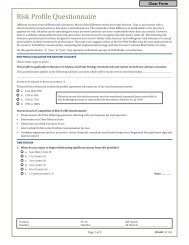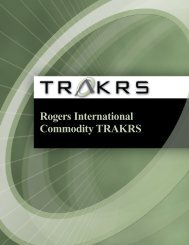The Inflation Cycle of 2002 to 2015 - Uhlmann Price Securities
The Inflation Cycle of 2002 to 2015 - Uhlmann Price Securities
The Inflation Cycle of 2002 to 2015 - Uhlmann Price Securities
Create successful ePaper yourself
Turn your PDF publications into a flip-book with our unique Google optimized e-Paper software.
Industrial Portfolio Strategy<br />
<strong>The</strong> <strong>Inflation</strong> <strong>Cycle</strong> <strong>of</strong> <strong>2002</strong> <strong>to</strong> <strong>2015</strong> ⎯ April 19, <strong>2002</strong> -14- Legg Mason Wood Walker, Inc.<br />
open <strong>to</strong> the improving conditions. <strong>The</strong> actual trend for real U.S. agricultural exports was 2.7% growth (PPI<br />
index year 2000) from 1962 <strong>to</strong> 1996, and we see real growth <strong>of</strong> only 2.4% from 1996 <strong>to</strong> <strong>2015</strong>E, or from<br />
$64.3 billion <strong>of</strong> real U.S. agricultural exports in 1996 ($52.3 billion in current, 2001 dollars) <strong>to</strong> $100 billion<br />
in <strong>2015</strong>. U.S. agricultural exports have been volatile, with inflation-adjusted U.S. agricultural exports rising<br />
from $27 billion in 1969 <strong>to</strong> a peak <strong>of</strong> $67.2 billion in 1980, but then plunging <strong>to</strong> $32.4 billion in 1986. Exports<br />
then climbed <strong>to</strong> a peak <strong>of</strong> $64.3 billion in 1996, on the strength <strong>of</strong> developing country demand and<br />
weather-related supply disruptions, but fell <strong>to</strong> $50.8 billion in 2000 before beginning a gradual recovery.<br />
Generally speaking, we see higher commodity prices, a weaker U.S. dollar, and improved emerging<br />
market economies, all <strong>of</strong> which support export prospects for U.S. farmers, in our view. <strong>The</strong> diminution<br />
<strong>of</strong> European Union (EU) and Former Soviet Union (FSU) grain and meat import markets, which had been<br />
the “s<strong>to</strong>ry” <strong>of</strong> the 1970s and 1980s but burst in the 1990s, is key. While the EU and FSU have contracted,<br />
the “new” markets in the Atlantic, Pacific and Middle East have continued <strong>to</strong> expand, which we believe is<br />
key <strong>to</strong> U.S. export prospects. A weaker U.S. dollar cycle also would assist U.S. farm exports, since U.S. agricultural<br />
exports fell 14.1% from 1995 <strong>to</strong> 2000, as the U.S. farm trade-weighted dollar rose 18.9% in that<br />
period. Since the U.S. farmer competes with currencies that may appreciate along with commodity prices (e.<br />
g., those <strong>of</strong> Canada, Australia, and the FSU), as well as against the low-priced European euro, the stage may<br />
be set for stronger U.S. agricultural exports in the coming decade. <strong>The</strong> U.S. Department <strong>of</strong> Agriculture<br />
(USDA) estimates agricultural exports <strong>of</strong> $54.5 billion in <strong>2002</strong>, up 10.8% from the trough <strong>of</strong> $49.2 billion<br />
in 1998, which we see as the beginning <strong>of</strong> a long-term recovery for various reasons outlined later in this report.<br />
As a result, we expect DE s<strong>to</strong>ck <strong>to</strong> outperform the S&P 500 more frequently in the period from <strong>2002</strong><br />
<strong>to</strong> <strong>2015</strong>.<br />
Although conditions have been less rosy for Deere in terms <strong>of</strong> U.S. agricultural trade since 1981, a favorable<br />
side effect has been farm machinery industry capacity rationalization. As <strong>to</strong>tal U.S. row crop<br />
trac<strong>to</strong>r plus combine harvester unit sales fell from 94,700 units in 1979 <strong>to</strong> 23,482 units in 2001, the farm<br />
machinery industry consolidated <strong>to</strong> a handful <strong>of</strong> global players. Also, the number <strong>of</strong> U.S. farms fell 10.9%<br />
from 1979 <strong>to</strong> 2001, and U.S. planted acreage fell 7.9%. Were it not for farm subsidies, capacity would have<br />
been reduced further, but we note that Deere targets larger, more pr<strong>of</strong>itable farms that tend <strong>to</strong> purchase and<br />
turn over equipment fleets more frequently. We discuss the farm outlook in greater detail later in this report.<br />
We view Joy Global (JOYG) as the quintessential coal play; seeking <strong>to</strong> participate in those cycles, we<br />
upgraded our rating on JOYG s<strong>to</strong>ck from Market Performance <strong>to</strong> Buy. We view JOYG s<strong>to</strong>ck as a<br />
prime beneficiary <strong>of</strong> the recovery <strong>of</strong> the worldwide coal, copper, and steel (via iron ore) prices, as well as<br />
the recent strength in gold mining, since the company is a dominant niche producer <strong>of</strong> electric shovels and<br />
underground coal mining machines. Having emerged from bankruptcy on July 12, 2001, with greatly reduced<br />
debt, Joy Global (formerly known as Harnischfeger Inc.) has been buffeted by an unusually warm<br />
winter that depressed electric utility output, and thus coal mining, since approximately 90% <strong>of</strong> U.S. coal is<br />
used <strong>to</strong> provide electricity, and utilities have accumulated coal inven<strong>to</strong>ry left over from the mild winter. We<br />
note, however, that coal inven<strong>to</strong>ry at electricity producers as a percentage <strong>of</strong> trailing 5-year average annual<br />
usage was 13.9% in 2001, versus 11.1% in 2000, but still below the 10-year average <strong>of</strong> 14.6%. In addition,<br />
electricity utility industrial production has begun <strong>to</strong> recover from the recession. Weak housing, au<strong>to</strong> and<br />
electronics markets also have depressed the copper and steel (iron ore) markets <strong>to</strong> which Joy Global sells,<br />
but those markets appear <strong>to</strong> be resilient and, as we said, we do not wish <strong>to</strong> fight the Fed anymore with respect<br />
<strong>to</strong> those early cycle groups, at least for the time being. Given that Joy’s wagon is tied <strong>to</strong> coal, in Exhibit<br />
7 we show that coal has provided 52% <strong>of</strong> growing U.S. electric power for the past 80 years with an an-








